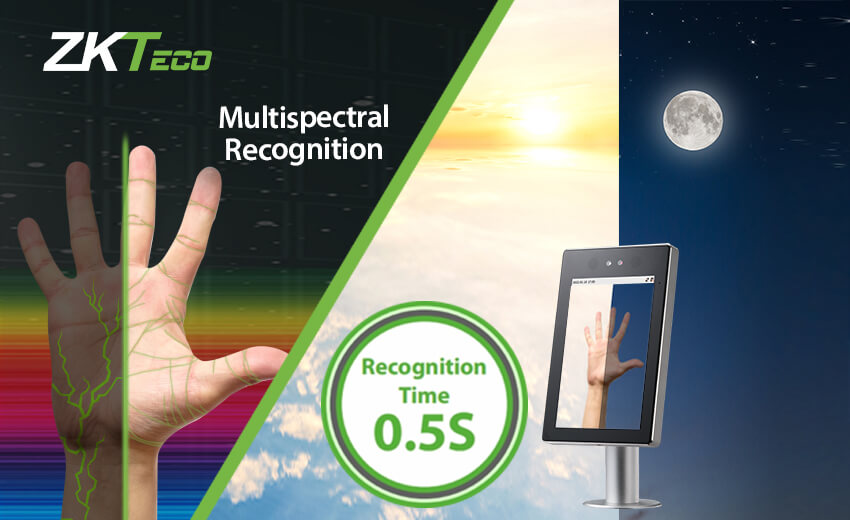One widely reported impact of the global Covid epidemic has been increased market demand for contactless biometrics. Government and businesses alike have been increasingly adapting different biometric technologies to address evolving requirements and challenges, while instituting measures to protect individual privacy.
One widely reported impact of the global Covid epidemic has been increased market demand for contactless biometrics. Government and businesses alike have been increasingly adapting different biometric technologies to address evolving requirements and challenges, while instituting measures to protect individual privacy.
It is into this growing market that
ZKTeco is launching its multispectral touchless palm recognition readers and sensors, which promise to set a new standard for next-generation biometric devices. Through advancements in computer vision and biometric technology, this new product series is set to offer users a higher level of security, reliability and protection.
The technology behind the new multispectral palm readers
ZKTeco has been developing palm readers since 2016 and has taken the lead in the miniaturization and cost reduction of palm readers. Whereas early versions required close recognition ranges (10 cm) and are mostly quite costly, these new versions offer the commercial market longer detection ranges, faster recognition speeds and better palm angle acceptance for a better user experience solution.
“Unlike the previous generation of palm readers, obtaining clear images is just the first step. At first, we used single spectral recognition – near-infrared palm technology, but by adding visible light, ZKTeco was able to develop a unique multispectral palm recognition technology. This has contributed to other breakthroughs as well – in algorithm adaptability, anti-spoofing ability and storage capacity (which grew from less than 1,000 to a maximum of 10,000 users),” said Paul Yang, Time & Attendance and Access Control Product Manager at ZKTeco.

Leveraging this new hybrid technology, the 3-in-1 screening of palm shape, palm print and palm vein greatly improves the new readers’ anti-spoofing capabilities. Any spoofing attempts would need to pass through three layers of protection or be refused further processing. Firstly, the algorithm needs to recognize that the object is a proper “palm shape.” Then the duo-camera palm image collection and positional calibration system precisely inspect the palm for anti-spoof features and maps the palm out. Finally, palm vein recognition is carried out to test for liveness detection, analyzing if the palm is “live” or “fake.”
The palm is challenging to read as it has smaller feature points and are less static compared to fingerprints. For this, ZKTeco developed a contactless acquisition algorithm that does not require full contact of the palm with the sensor. “Angle tolerance for palm alignment was increased to up to 25 degrees, with better visibility under changing lighting conditions (0 to 100,000 lux) and less “smearing” of images upon accidental movement,” shared Yang. “Palm print and vein pattern detection have also improved, now possible from a distance of 0.2m to 0.5m and takes less than 0.35 secs.”
These key improvements in the new generation of readers came about through a combination of computer vision and algorithms. “We spent a lot of time and effort to collect a large number of palm samples to train and fine-tune our algorithms which continue to learn by themselves. Users will find that the performance actually improves the more it’s used. Optimizing the algorithm allows it to adapt to user changes that can result from palm injuries or natural aging, and update the palm model with better quality ones,” said Yang.
Touchless biometrics and privacy
With biometrics becoming more advanced and accurate, its use has been expanding significantly within the public and private sectors across the globe. “This type of solution is very popular in Muslim countries like in the Middle East and Indonesia,” said Yang. “This offers touchless biometrics to users who cover their faces, perhaps for religious or cultural reasons. The technology covers every skin color and can be used by everyone in the world.”
However, biometrics may challenge the notion of privacy and consent. Facial, iris or fingerprint recognition technology allows passive collection of an individual’s biometric information – facial images can be taken from photos or surveillance footage and fingerprints can easily be lifted from previously touched items with or without the person’s knowledge.
Of course, proper governance is important when adopting and using biometrics, with oversight and accountability vital to ensure they are being used appropriately. But palm recognition can be an option that can provide organizations and individuals a level of control over their data. “Palm recognition requires the individual to actively provide their biometric characteristic (place their palms on the reader), which would then be matched to existing information in a database. As such, individuals can still actively choose if and when they want to share their biometric information. This provides them a certain degree of consent over their biometric information – what is collected and how it is used,” said Yang.